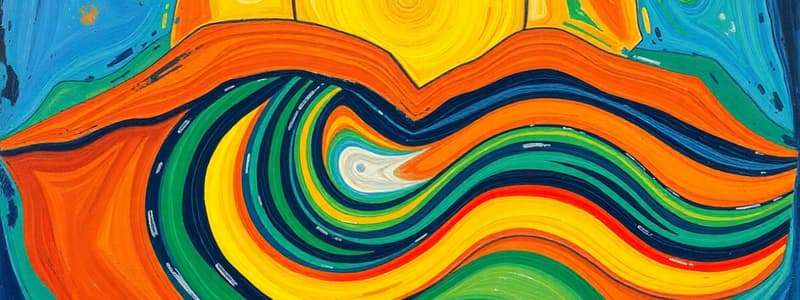Podcast
Questions and Answers
Which of the following statements accurately describes the relationship between tectonic plates and earthquakes?
Which of the following statements accurately describes the relationship between tectonic plates and earthquakes?
- Earthquakes predominantly occur along the boundaries between tectonic plates where they interact. (correct)
- Earthquakes primarily occur in the center of tectonic plates due to the concentration of stress.
- Tectonic plates have no correlation with the locations of earthquakes.
- Earthquakes rarely occur near tectonic plate boundaries, as these areas are geologically stable.
How are tsunamis related to earthquakes, and what is a common misconception about tsunamis?
How are tsunamis related to earthquakes, and what is a common misconception about tsunamis?
- Tsunamis are caused by volcanic eruptions and are often mistaken for rogue waves.
- Tsunamis are caused by underwater earthquakes and are often mistakenly called tidal waves. (correct)
- Tsunamis are caused by earthquakes on land and are often referred to as storm surges.
- Tsunamis are unrelated to earthquakes and only occur due to extreme tidal forces.
What is the correct sequence of an earthquake, from its origin to its detection?
What is the correct sequence of an earthquake, from its origin to its detection?
- Seismic wave generation → fault rupture → focus formation → seismograph detection
- Focus formation → fault rupture → seismic wave generation → seismograph detection (correct)
- Fault rupture → seismic wave generation → focus formation → seismograph detection
- Seismograph detection → seismic wave generation → fault rupture → focus formation
Which of the following scenarios best describes an intraplate earthquake?
Which of the following scenarios best describes an intraplate earthquake?
If a seismograph located 500 km away from an earthquake epicenter detects a significant increase in wave amplitude, what can be inferred about the earthquake?
If a seismograph located 500 km away from an earthquake epicenter detects a significant increase in wave amplitude, what can be inferred about the earthquake?
Flashcards
What is an Earthquake?
What is an Earthquake?
Sudden shaking of the ground caused by movement within the Earth's crust.
What are Faults?
What are Faults?
Cracks in the Earth's crust where movement occurs, often the site of earthquakes.
What are Tectonic Plates?
What are Tectonic Plates?
Pieces of Earth's crust and upper mantle that move and interact, causing earthquakes.
What is a Tsunami?
What is a Tsunami?
Signup and view all the flashcards
What is the Focus (of an Earthquake)?
What is the Focus (of an Earthquake)?
Signup and view all the flashcards
Study Notes
- Earthquakes involve a sudden, violent shaking of the ground due to movement within the Earth's crust.
- This movement stems from energy release, often near a fault or crack where movement occurs.
- Mechanical waves propagate this energy through rock layers, radiating outward.
- Seismographs, delicate instruments, measure and record the motion of these seismic waves.
Earthquake Location
- Most earthquakes occur on faults, specifically those along tectonic plate boundaries.
- Tectonic plates comprise the Earth's crust and uppermost mantle (lithosphere).
- Convection within the mantle primarily drives their movement and interaction.
- Earthquakes can happen anywhere on the Earth's surface, including underwater.
- Underwater earthquakes can cause tsunamis, large water waves, which can cause surges of water inland.
- Some earthquakes occur on intraplate faults, located within tectonic plates, like the New Madrid Fault.
Earthquake Components
- Focus: The origin point of the earthquake, defined by geographic location and depth, marking the start of the event.
- Seismic Waves: Mechanical energy propagating through Earth's layers, categorized into Body (primary/secondary) and Surface (Rayleigh/Love) waves.
- Fault: A line where rock sections can move against each other, releasing mechanical energy through slip.
Focus vs Epicenter
- Epicenter: It is the surface location directly above the focus.
- Focus: The location of the earthquake at depth.
- Hypocenter: A synonym for the focus.
Seismic Waves
- Primary (P-) waves: They are compressional/longitudinal waves, the fastest, arriving first at seismographs.
- Secondary (S-) waves: They are transverse waves, arriving second at seismographs, and are body waves.
- Rayleigh waves: Longitudinal waves causing elliptical shaking, diminishing with depth, and are surface waves.
- Love Waves: Transverse waves causing shear shaking, and are surface waves.
Fault Types
- Thrust or Reverse Faults: Vertical slip with one block moving upwards relative to the other.
- Normal Faults: Experience vertical slip with one block moving downwards relative to the other.
- Strike-slip Faults: Horizontal movement where blocks slide past each other.
Earthquake Causes
- Caused by tectonic plates moving; pressure builds near the surface.
- Rock breakage releases stress, converting it into mechanical energy that propagates as seismic waves.
- Compressional stress: Objects colliding (reverse fault).
- Tensional Stress: Rock pulling apart (normal fault).
- Shear Stress: Objects sliding past each other (strike-slip fault).
Earthquake Types
- Tectonic: Occur due to sliding along a fault or tectonic boundary.
- Volcanic: Triggered by nearby volcanic activity.
- Collapse: Small earthquakes in caves or mines caused by surface explosions.
- Explosion: Result from nuclear or chemical bomb detonations.
Earthquake Stages
- Elastic Build-up: Elastic strain accumulates as faults move, compressing rocks over time.
- Dilatancy: Rocks crack to create space, expelling water and intaking air, increasing elastic strain capacity.
- Influx of Water: Water re-enters cracks, weakening the rock and preventing further cracking.
- Earthquake: The fault ruptures, releasing stored energy and generating seismic waves.
- Aftershocks: Smaller ruptures occur due to stress reduction, releasing remaining elastic strain unpredictably.
- Foreshock: Small release of elastic strain before the main earthquake, which isn't always present.
Studying That Suits You
Use AI to generate personalized quizzes and flashcards to suit your learning preferences.
Description
Earthquakes are sudden ground shaking events caused by energy release in the Earth's crust, often along faults. Seismic waves propagate this energy, measured by seismographs. Most earthquakes occur at tectonic plate boundaries, driven by mantle convection.




